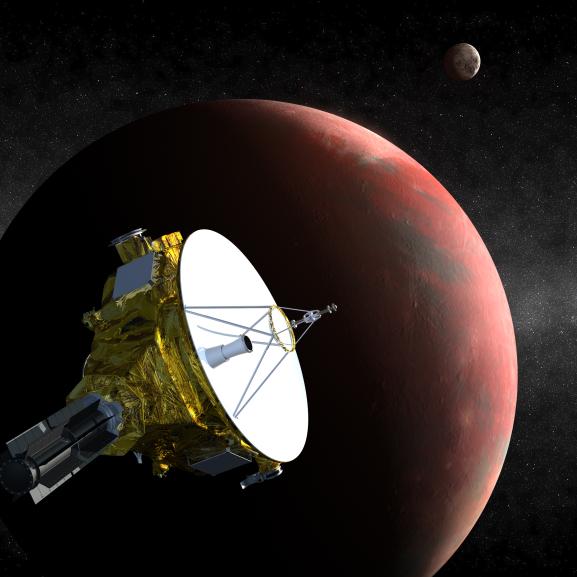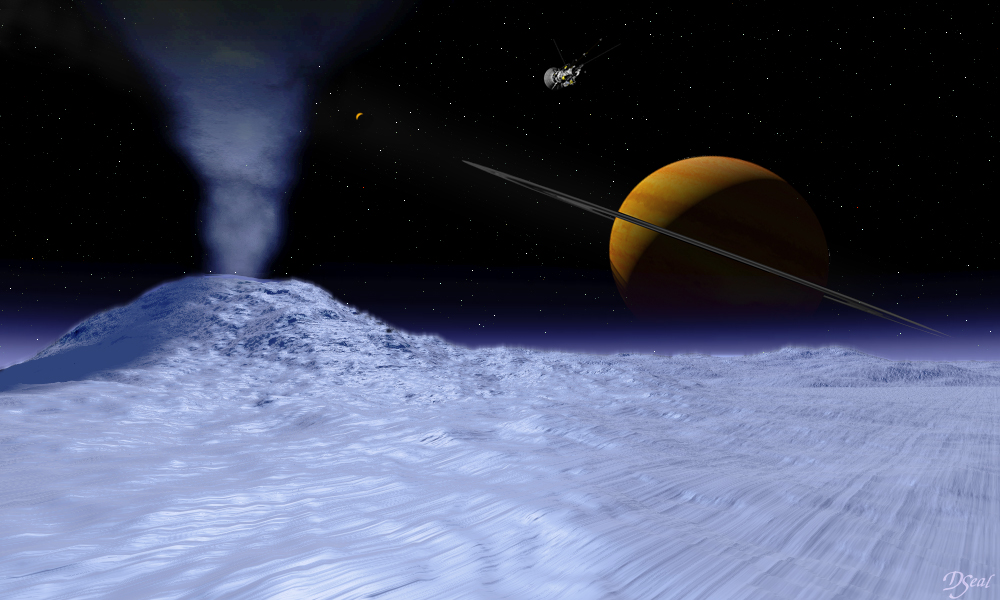NASA Probe to Search for Pluto's Hidden Ocean

When NASA's New Horizons cruises by Pluto in 2015, the images it captures could help astronomers determine if an ocean is hiding under the frigid surface, opening the door to new possibilities for liquid water to exist on other bodies in the solar system. New research has not only concluded such an ocean is likely, but also has highlighted features the spacecraft could identify that could help confirm an ocean's existence.
Pluto's outer surface is composed of a thin shell of nitrogen ice, covering a shell of water ice. Planetary scientists Guillaume Robuchon and Francis Nimmo, both of the University of California at Santa Cruz, wanted to find out whether or not an ocean could exist underneath this icy shell, and what visible signs such an ocean might produce on the surface.
The pair modeled the thermal evolution of the dwarf planet and studied the behavior of the shell to see how the surface would be affected by the presence of an ocean below.
Searching the surface
Ironically, the easiest feature to identify would appear if no ocean existed. [Pluto: A Dwarf Planet Oddity]
As spherical bodies spin, their angular momentum tends to push material towards the equator, forming a bulge. If Pluto boasts a liquid layer, the ice would flow, reducing such a protrusion. Thus, the appearance of a "frozen-in" primordial bulge, left over from when Pluto spun more rapidly, would signify a lack of ocean.
"If the bulge is present, it will be about 6 miles (10 km) high, so it should be readily detectable," Nimmo said.
Get the Space.com Newsletter
Breaking space news, the latest updates on rocket launches, skywatching events and more!
New Horizons project scientist Hal Weaver agreed on the last point.
"New Horizon imaging will measure the shape of Pluto very accurately."
Launched in 2006, the NASA mission should reach Pluto in April of 2015. In addition to determining the contours of Pluto, it will also study the temperature, the atmospheric makeup, and the solar wind around the distant planet.
The surface features and composition also will be targets. These surface features could provide hints as to what lies beneath.
As Pluto cooled over its lifetime, the temperature changes resulted in a change in volume, creating surface stresses. Classifying these features should reveal whether or not they overlie an ocean.
Icy water beneath the shell would result in tensional stresses as the ice was stretched, while a solid layer would have meant compressional stresses as the material was squeezed.
Such fractures would likely span the globe, rather than being unique to specific areas.
This is ideal, since New Horizons will not map the entire surface of Pluto. Because of the complications involved in going into orbit, the craft will only fly past the icy dwarf planet. But imaging will begin around three months before its closest approach.
"New Horizons will map the entire sunlit surface of Pluto," Weaver explained, "but only the hemisphere facing the spacecraft near the time of the flyby will be mapped at the highest resolution."
The highest resolution will capture 62 meters per pixel when the craft is within 7,750 miles (12,500 km). However, the more distant images still will be approximately ten times more detailed than those captured by the Hubble Space Telescope.
Ridges and valleys with heights and depths of 260 feet (80 meters) should be distinguishable.
Other potential features include geysers similar to those found on Saturn's moon Enceladus and Neptune's moon Triton.

Water on an icy planet
At an average of forty times the distance from the sun to the Earth, Pluto seems an unlikely candidate for harboring an ocean, even underground. But the heat that might melt the ice would come from inside.
The main source of energy likely stems from the rocky interior, where isotopes undergo radioactive decay. Among these elements, the researchers found potassium to be key - enough potassium in Pluto's core would result in melted ice above it.
And signs look good - the amount of potassium needed would be about a tenth of that found in meteorites from the early solar system.
"I think there is a good chance that Pluto has enough potassium to maintain an ocean," Nimmo said.
An important factor that would influence the formation of an ocean is the viscosity of the ice, or how much it resists flowing. A slushier ice shell would suck the heat from the water beneath it, causing the ocean to freeze, while a more solid, high-viscosity shell would not.
According to the models, the planet-wide ocean would have an average depth of approximately 100 miles (165 km), beneath a crust of ice of the same thickness.
The growing habitable zone
Scientists regard water as necessary for life as we know it, so focus tends to fall on the habitable zone around stars, the region where temperatures allow for liquid water to exist on a rocky planet.
But in our solar system, liquid water is already anticipated to exist outside this region. Jupiter's moons Europa, Ganymede, and Callisto may each contain a sea beneath their icy surfaces, and Saturn's moon Titan also shows hints of an underground water ocean.
According to Nimmo, Pluto is unlikely to contain life because the organic nutrients considered necessary were probably leached away years ago.
However, if a subsurface ocean exists on the dwarf planet, then other objects in the Kuiper belt are potentially more habitable than previously suspected.
"They almost certainly have oceans too, since some are about the size of Pluto," Nimmo said.
Such objects could contain not only liquid water but the necessary ingredients for life that Pluto probably lacks.
Join our Space Forums to keep talking space on the latest missions, night sky and more! And if you have a news tip, correction or comment, let us know at: community@space.com.

Nola Taylor Tillman is a contributing writer for Space.com. She loves all things space and astronomy-related, and enjoys the opportunity to learn more. She has a Bachelor’s degree in English and Astrophysics from Agnes Scott college and served as an intern at Sky & Telescope magazine. In her free time, she homeschools her four children. Follow her on Twitter at @NolaTRedd










